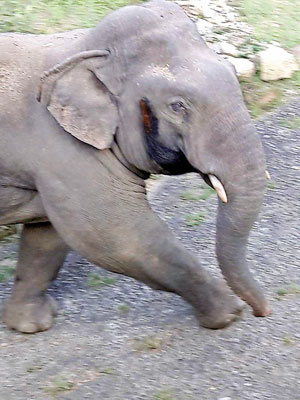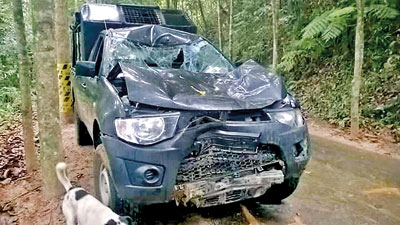News
Sinharaja elephant attacks raise villager fury
View(s):By Malaka Rodrigo
Sri Lanka’s biodiversity hotspot, Sinharaja, is home to two elephants – but pressure is mounting to translocate them after one killed two villagers. Last week, some angry villagers demanded the elephants be removed as a man and a woman were killed in Cypresswatte village.

The recent photograph that shows an elephant in musth
The incident happened on May 16. The woman was killed at about 6:45 p.m., while the man was fatally attacked around 8 p.m.
A few days earlier, on May 13, the same elephant attacked a Wildlife Department jeep when the vehicle was involved in chasing the animal back into the forest. This incident was near Kudawa, Weddagala around 8.30 p.m. The panicked animal turned back and crushed the bonnet of the vehicle, slightly injuring those inside.
The elephant had been seen at other locations. It had paced around the tower on top of the Gongala Mountain. A photo taken at Gongala shows the elephant is in musth, which is the periodical rise of reproductive hormones of a bull elephant. At such times the animals are irritable and aggressive.
According to DWC records, the two Sinharaja elephants are responsible for 16 human deaths in villages such as Kopi-kella, Manikkawatte and Cypresswatte. Tea cultivations block their natural passages, forcing them to sometimes wander into populated areas.
Madura De Silva, the president of the Wildlife Conservation Society of Galle, said that there were three elephants sometimes back – one female and two males. The society setup camera traps as a part of a project related to leopards and the cameras captured the movements of an elephant. With the data they mapped its range.
DWC director general, W S K Pathiratne, said a decision had not been taken yet to translocate the killer elephant. More wildlife officers will be sent to the are.
 When asked if a radio collar could be fitted to track the animal, he said trapping the elephant would be challenging in the difficult terrain.
When asked if a radio collar could be fitted to track the animal, he said trapping the elephant would be challenging in the difficult terrain.
The elephant was in fact caught in 1999 by a team led by Dr Nandana Atapattu – a veterinary surgeon who was also a deputy director of DWC then. It took a team of 20 and a week-long effort. But villagers at the time, particularly the students of Kajuwatta School protested against removing the elephant saying it was an asset to the area. Dr Atapattu released the elephant.
At that time, there were records that the elephant charged but did not kill anyone.Environmentalist Jayantha Wijesinghe said these elephants roamed widely around Sinharaja, but attacked people only in some places. “The reason being that the villagers in these areas have harmed the duo, so the elephants become more aggressive,” he said.
The president of the Wildlife Conservation Society of Galle, Mr De Silva, said that in many areas, the local villagers understand the elephant’s movements and that helps to avert a potential disaster. He also said that because of the elephants, illegal activities such as felling trees for ‘walla patta’ and gem mining has been under control. “These elephants are the jewels of Sinharaja. it is better to let them be.”
The Sinharaja rainforest is a UNESCO World Heritage Man and Biosphere Site.

